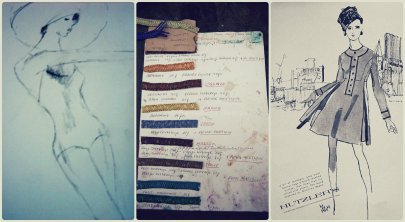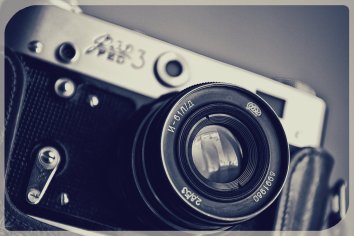As promised, FTL is continuing with the “Hey! Hands off my IP!” series of blog posts. The first post in the series was on trade marks, you can access it here. Next we take a look at copyright.
It’s a common error to mistake copyright as a registerable right and get it confused with a trade mark. This piece aims to demystify the differences, provide greater clarity on copyright and explain why it’s a useful tool for those in the fashion/fash tech industries.

Protect your designs and avoid copyright infringement by reading on…
What’s copyright?
Contrary to some general public perception, copyright cannot be legally registered in the UK, which is one of the key differences often confused with a trade mark.
Recently when listening to the radio (yes I’m a retro gal!), I heard numerous presenters assuming that certain objects, lyrics and recipes need to be registered to attain copyright. WRRRRONG!! This really infuriates me…

Glued to my radio!
Copyright automatically arises on the creation of a Work. An idea alone cannot generate protection, the idea must be Recorded to become protectable under copyright. The Work must also be Original.
What does it mean to be a Work, Recorded and Original?
A Work: to be classified as a Work, the piece must fall within one of the following categories (for the legislation buffs out there, the relevant statute is here):
• a literary, dramatic, musical or artistic work;
• a sound recording, film or broadcast; or
• the typographical arrangement of a published edition.
For those in the fashion industry, this could include sketches of new clothing, handbag designs, shoe drawings, photographs of mock-ups or photos of the final product for example. However the garments themselves would not generally be protected by copyright, as it would be hard to drop them into one of the above categories.

Copyright would exist in these very designs!
It’s worth noting that in other countries, garments can be protected by copyright due to their more openly drafted laws on copyright. This is the case in France, Germany and the US and was how Bijules could register its nail ring for copyright protection in the US.
Fixation: A further hurdle to leap before copyright protection applies is that the Work must be fixed. This means the literary, dramatic, musical or artistic work, for example, must be put “in writing or otherwise” (section 3(2), Copyright designs and Patents Act 1988, or CDPA for short!).

“Record” everything to achieve fixation!
Originality: Finally, the work must be Original! It’s no good copying someone else’s work and then claiming copyright in it – that won’t work!!
Interestingly, it’s not necessary for the whole piece to be original for copyright to exist. Generally, the level of originality required in the UK is low; for example, copyright in calendars and competition cards have been accepted in the UK.
For fashion photographers, originality of photographs has raised questions, but European law states that:
“Photographs which are original in the sense that they are the author’s own intellectual creation shall be protected… “

Photographs are able to achieve copyright protection. Follow the steps outlined above to ensure they’re safe!
Who owns copyright?
Normally the owner of copyright within a Work will be the creator. However Works created in the course of employment by an employee will usually be owned by the employer, due to express terms in the employee’s contract.
Also, where a piece is commissioned, let’s say Vogue UK commissioned the famous milliner Philip Treacy to create an exclusive design as part of the 2016 100th year anniversary, it’s unlikely that Vogue would fail to formally contract with Treacy to secure Vogue’s ownership of any copyright in the design. So here, the commissioning party will typically own the copyright.

Philip Treacy’s amazing creation for the late Alexander McQueen’s Spring/Summer 2008 collection. Wonder if Treacy was commissioned by McQueen and if so, who owned the copyright!?
How long does copyright last for?
Copyright exists from the moment a work has been created. The duration of this depends on the type of work created, by way of example, an artistic work affords protection for 70 years from the death of the author/creator.

Vogue is celebrating its 100th year this year! Continuing the theme, copyright even exists in these vintage Vogue covers dating all the way back to 1916, provided the date of the author’s death was not before 1946 of course!
What rights does copyright give the owner?
The copyright owner has the exclusive right to do the following with the Work:
• copy it;
• issue copies to others;
• rent it out;
• perform, show or play it in public;
• communicate it to the public; and
• make an adaptation.
Are any rights reserved for a creator who may no longer own the Work?
The author automatically acquires a number of moral rights in relation to their Work including rights:
• to be identified as the author;
• to object to derogatory treatment of the Work; and
• not to have a Work falsely attributed to him or her.
What happens when someone breaches copyright?
Copyright is infringed if, without the permission of the owner, someone does, or authorises another to do, any of the acts that are exclusive to the copyright owner as outlined above.

Universal sign for copyright. Stamp on all of your works capable of copyright protection to warn off any copyright thieves!
This can apply to the whole of the Work or only part of it and relates to direct or indirect infringement.
Round up
Being an automatic right, and not one that can be legally registered in the UK, copyright can often be difficult to prove. For example, a startup fashion business may create a wonderful design, which is then totally ripped off by large corporate retailer. The startup may not have filed evidence of its creation, which would prove originality prior to the date the corporate giant made a copy. The startup would therefore find it difficult to its ownership of the Work.

Although your studio may only have humble beginnings, be sure to record your original works to benefit from copyright protection!
What can be done?
A way around this is to record and keep dated copies of your file drawings, plans and photographs. This will then go some way to prove you are the owner and that the Work does not belong to those trying to steal your work!
Copyright can be mind-boggling and legal advice often needs to be tailored on a case by case basis. If you’ve hit a copyright wall and don’t know where to turn, contact FTL via the contact me page.
Until next time…
Brilliant read, very interesting topic.
LikeLiked by 1 person
Thanks Ann, really pleased you enjoyed it!
LikeLike